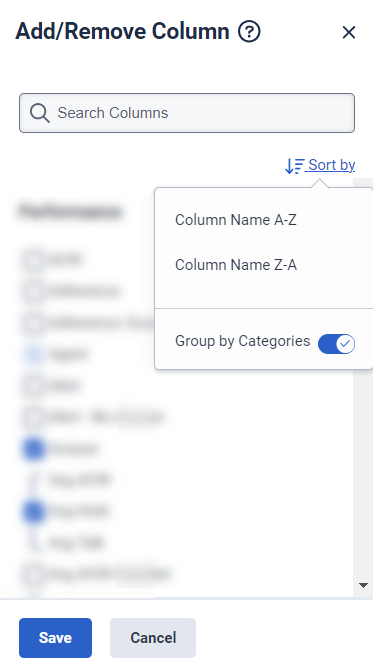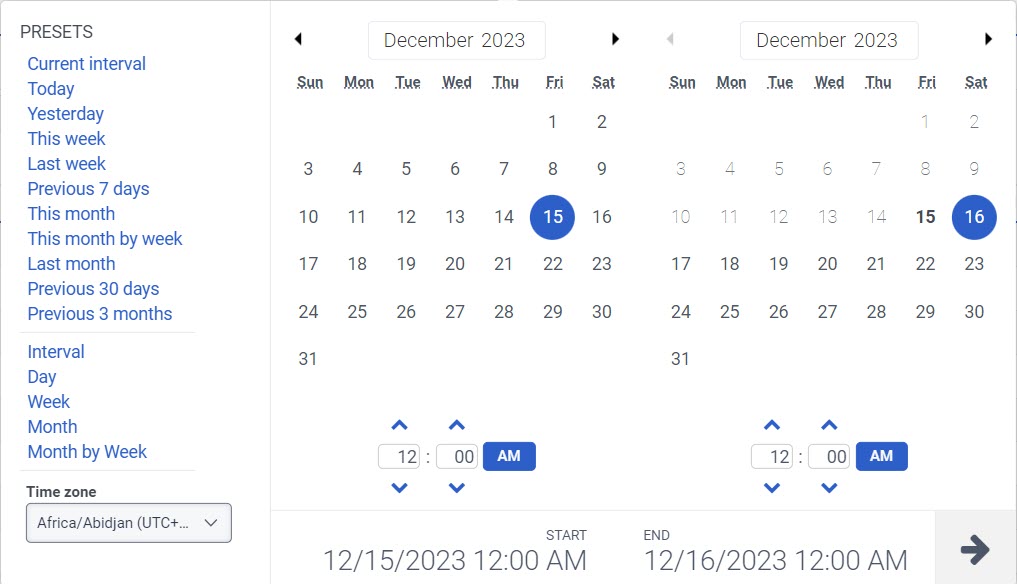My Status view
The My Status view displays real-time information about your statuses, including the length of time that you stayed in each status. Data in the columns updates when you leave a status. This view updates automatically.
This view performs live updates to data in the real-time columns if you view a date range that includes the current interval such as today, this month, and more.
This view does not perform live updates to data if you view a historical date range that does not include the current interval.
To see the most current data, click Refresh .
Available columns
To view the available columns, see My Status view section in the View available columns in performance views by category article.
To view the consolidated list of available columns in the performance views, see Consolidated view of available columns in performance views.
To view the list of available columns in the performance views by category, see View available columns in performance views by category.
Set a default time zone in the workspace
You can set the default time zone in the analytics workspace before viewing any analytics view.
To set the default time zone in the workspace, follow these steps:
- Click Performance > Workspace.
- On the left side, from the Time zone drop-down menu, select the required time zone as the default time zone for the analytics workspace.
View your status data
- Click Performance > Workspace > My Performance > My Status.
- To save the view with your filter and column settings, click Save .
- To export the data in the view, click Export .
- Click the tabs to open your My Performance, My Evaluations, My Schedule, and My Development views.
Activate yourself for queues
Choose which queues to work by activating and deactivating queues. After you activate a queue, when you are On Queue, you receive interactions from that queue. You must be a member of a queue in order to activate or deactivate it.
To activate or deactivate queues from this view:
- Click the Queue Activation icon
 .
. - Select the queues you want the agent to work.
- Click Update.
Customize the view
Customize the view to show only certain data. For example, you can choose to show only certain columns or filter to show previous weeks. Your customizations remain as you navigate from view to view or leave and return to a view. You can also save your filter and column settings as a saved view to switch between different data of interest in the same view quickly.
To customize analytics views, use the date filter.
To filter metrics by date or configure a custom date range, use presets. When filtering metrics for this view, select any custom date range up to 6 weeks.
To use a preset to filter metrics, complete the following steps:
- To display the date filter, click the date.
- In the Presets list, select a preset date option.
Date presets
| Presets | Description |
|---|---|
| Current interval | Shows data for the current 30-minute time period. |
| Today | Shows data for the time period that includes the current interval. |
| Yesterday | Shows data for the previous day. |
| This week | Shows data for a Sunday through Saturday time period. |
| Last week | Shows data for the previous week, Sunday through Saturday. |
| Previous 7 days | Shows data for the previous seven days. |
| This month | Shows data for the current month, with no extra days. |
| This month by week | Shows data for the current calendar month starting on Sunday and ending on Saturday, including extra days if the month does not start on Sunday or end on Saturday. |
| Last month | Shows data for the previous calendar month with no extra days. |
| Previous 30 days | Shows data for the previous 30 days. |
| Previous 3 months | Shows data for the previous 3 months. For example, Nov 1, 2022 – Jan 31, 2023. |
| Interval | Shows data for a 30-minute time period. |
| Day | Shows data for a single 24-hour day. |
| Week | Shows data for a Sunday through Saturday time period. |
| Month | Shows data for the exact month with no extra days. If the current month is selected, you can see the data up to the current date. |
| Month by Week | Shows data for a calendar month starting on Sunday and ending on Saturday, including extra days if the month does not start on Sunday or end on Saturday. |
To use a custom date range to filter metrics, complete the following steps:
- Click the date to display the date filter.
- Select a start date and an end date on the calendar, and click the filter arrow .
To view data for a different time period using the same date presets, click the arrows on either side of the date display. ![]()
For example, to view data for the previous day, click the Day preset, and then click the arrow on the left side of the date.
To view data for a different time zone using the same date presets, from the Time zone drop-down menu, select the required time zone. You can create and save reports with the same selected time zone.
Data in the view can be displayed in a chart. To view the chart, click the Show/Hide chart icon .
To show or hide columns:
- Click the Pick columns icon on the right side. The Add/Remove Column pane appears.
- (Optional) To sort the columns in ascending or alphabetical order, click Sort by > Column Name A-Z.
- (Optional) To sort the columns in descending or reverse alphabetical order, click Sort by > Column Name Z-A.
- (Optional) To categorize or uncategorize the columns, click Sort by and enable or disable the Group by Categories toggle. Click the image to enlarge.

- Search or scroll to select the columns you want to view. Note: You can also use keyboard navigation to choose the columns.
- Click Save. The selected columns appear on the screen. Note: The column selections appear only after saving the changes and do not apply to the table immediately.
To rearrange the columns, click a column header and drag it.
To reset a view to default column settings, click Reset view to defaults ![]() .
.
You can select up to 20 columns.
For more information about the metrics shown in the columns, see the Available Columns section in this article.
When the table columns are sorted as default, the My Status view displays certain columns together as groups. To rearrange column groups, click a column group header and drag it.
To reorder columns within the column groups:
- Click the Pick columns icon .
- In the Table Columns pane, hover over the table column header name you want to move.
- Click the up or down arrows.



